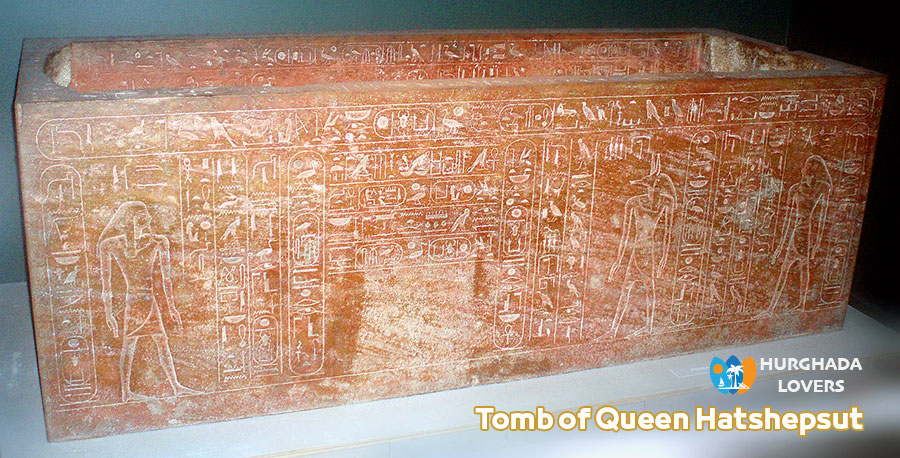Tomb of Queen Hatshepsut in the Valley of the Kings, Luxor, Egypt | Facts KV60 & History Building Pharaonic Egyptian Tombs in the Eighteenth Dynasty of Egypt “The New Kingdom” and more about Cemetery Design and Decoration, Entry Ticket Prices.
Facts and history of building pharaonic tombs in the civilization of ancient Egypt, the eighteenth dynasty, and more. Cemetery design, visiting dates, entry ticket prices…
She is one of the kings who were buried in a tomb and then moved to another tomb, and the first tomb in which the queen was buried is tomb 20, and its owner was Thutmose I and Hatshepsut, while she was then transferred to tomb 60, know information about both of them.
Hurghada lovers Offer Luxury Hurghada to Luxor Tours | El Gouna to Luxor Tours | Makadi bay to Luxor Tours | Sahl Hasheesh to Luxor Tours | Soma bay to Luxor Tours.
Tomb of Queen Hatshepsut Facts
- It was discovered that the Pharaonic architect Senenmut built and carved the burial chamber of Queen Hatshepsut on the same axis as her temple in the Deir El Bahari area in a unique geometric style.
- You will find it difficult to descend through a 220-meter-long underpass that ends at the entrance to the Royal Cemetery.
- Hatshepsut is the queen who ruled Egypt from 1479 to 1458 BC.
- She married Thutmose II and gave birth to Neferti Ra. Her father was Thutmose I and mother Ahmose.
- The queen was first buried in the tomb of her father, Tuthmosis I, which is universally known as KV20 and is located in the Valley of the Kings in Egypt.
- It is said that this cemetery was initially the seat of the burial of King Tuthmosis I, but was later used by Hatshepsut.
- Hatshepsut expanded the cemetery to be a shelter for her next to her father.
- The cemetery was discovered since the French campaign in 1799 AD, when the scholars of the campaign learned that this cemetery existed until it was recorded in their records.
- The tomb was later discovered and studied by Howard Carter in 1903 AD.
- Tomb Twenty comes with a length of 210 meters in a clockwise direction.
- The sarcophagus of Queen Hatshepsut, made of yellow quartzite, was found empty, and it is now displayed in the Egyptian Museum in Cairo.
Tomb of Queen Hatshepsut
- This cemetery is also located in the Valley of the Kings, but in the eastern valley of the valley.
- It was discovered by Howard Carter in 1903 AD.
- This cemetery was a little confusing to some, as it was not agreed at first on the identity of the mummy that was found there.
- Some believe that the female mummy is Queen Hatshepsut, and this is the opinion of Elizabeth Thomas.
- When that cemetery was discovered, Carter found that it had been robbed and even desecrated in the ancient era.
- However, there were two mummies, beside damaged belongings.
- The cemetery was reopened in 1906 AD again by Edward Aton.
- Edward took out the mummy and the coffin and then transferred them to the Egyptian Museum.
- An inscription was found on a coffin bearing the name of the royal family nurse.
- Here, she was identified as Queen Hatshepsut’s nurse.The location of the cemetery was forgotten after that, because its location was not recorded by the discoverers.
cemetery date 60 – Tomb of Queen Hatshepsut
- Elizabeth Thomas then expected that the second mummy is Queen Hatshepsut, and that he placed here is Pharaoh Thutmose III, who held a grudge against her.
- In 1990 the tomb was discovered again and studied by the team of Donald Ryan and Mark.
- The team concluded that the second mummy belonged to a somewhat elderly woman and that her left arm was in a flexed position.
- That position was the practice of mummification workers for kings, and pottery vessels bearing the name of Queen Hatshepsut were found in the tomb.
- From the evidence that also proved that this mummy is Hatshepsut, which is the presence of a fake wooden face of the beard, despite the absence of any males in the tomb.
- It was known that Queen Hatshepsut wore a fake beard, so it was inferred that she was transferred to that tomb.
The discovery of the mummy of Hatshepsut
- The tomb was opened again in 2007 and the second mummy was removed to be tested.
- Zahi Hawass, director of the Supreme Council of Antiquities, found conclusive evidence that the mummy was Queen Hatshepsut.
- Evidence is the CT scan, which showed the presence of a missing molar from the lower jaw of the mummy.
- A canopic box was found bearing the name of Queen Hatshepsut, with the missing molar inside.
- The evidence provided by Zahi Hawass that there is a great similarity between the missing molar and the molar that was found when the size of the molar and root was compared has been questioned.
- Dylan Bickerstaff questioned Zahi Hawass’s point of view and said that the evidence should be DNA.

